Health Disparities in Indigenous Australians: Literature Review
VerifiedAdded on 2023/06/05
|13
|3594
|414
Literature Review
AI Summary
This literature review examines the health and well-being of Australian Indigenous people, focusing on factors leading to health disparities. The study utilizes interviews with non-Indigenous health professionals in Western Australia to explore challenges in healthcare delivery, particularly the impact of Anglo-Australian cultural supremacy and racism. The methodology includes audio-taped interviews, transcription, and analysis using QSR NVIVO software, with inclusion and exclusion criteria to ensure participant eligibility. Findings reveal that racism is a fundamental concern, influencing the healthcare sector and leading to interpersonal and institutional discrimination. The review highlights the importance of addressing these issues to improve health outcomes, acknowledging limitations such as the small sample size. The study emphasizes the need to address communication breakdowns, lack of cultural sensitivity, and inadequate interpreting services. The review concludes with a discussion of the impact of racism on healthcare outcomes for Indigenous Australians and the need for systemic changes.
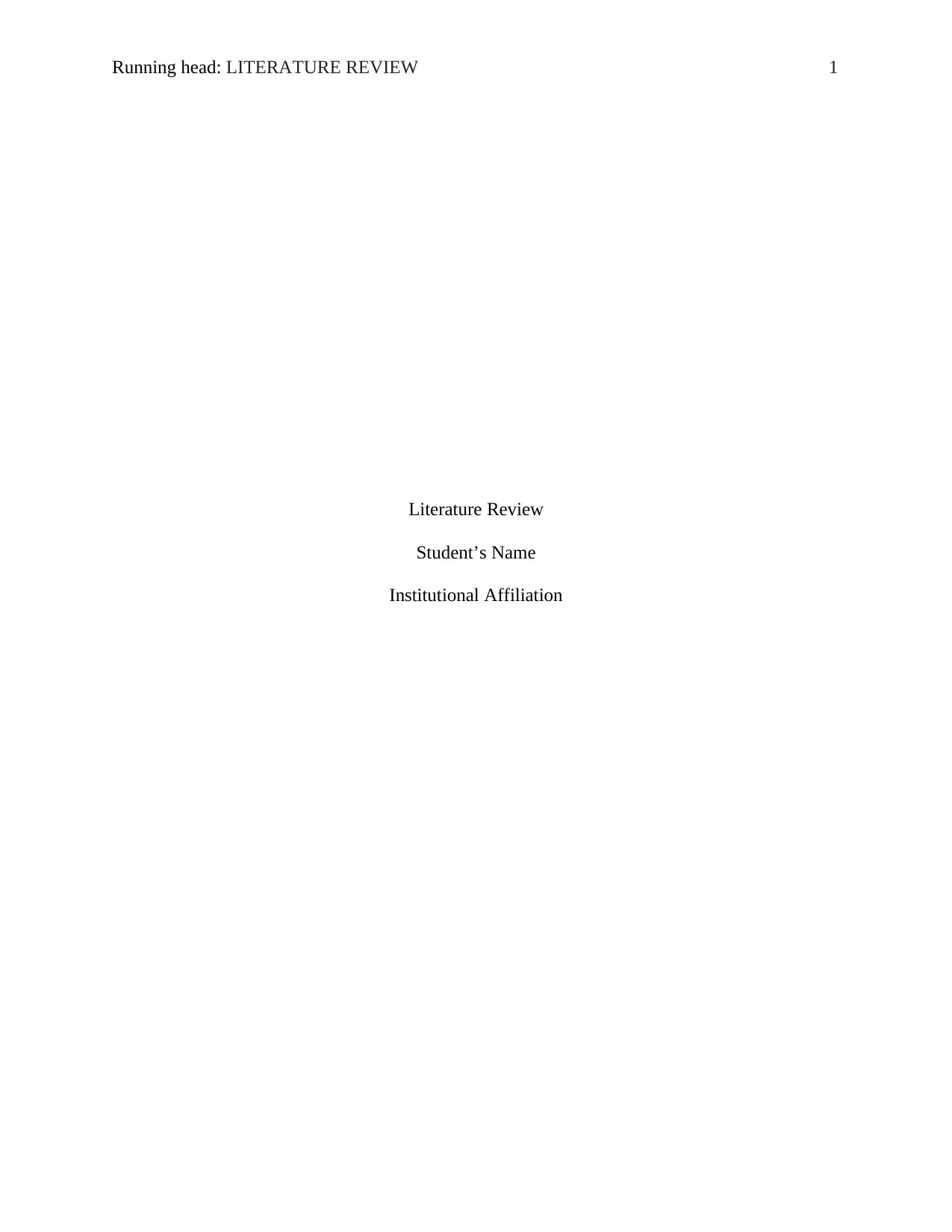
Running head: LITERATURE REVIEW 1
Literature Review
Student’s Name
Institutional Affiliation
Literature Review
Student’s Name
Institutional Affiliation
Paraphrase This Document
Need a fresh take? Get an instant paraphrase of this document with our AI Paraphraser
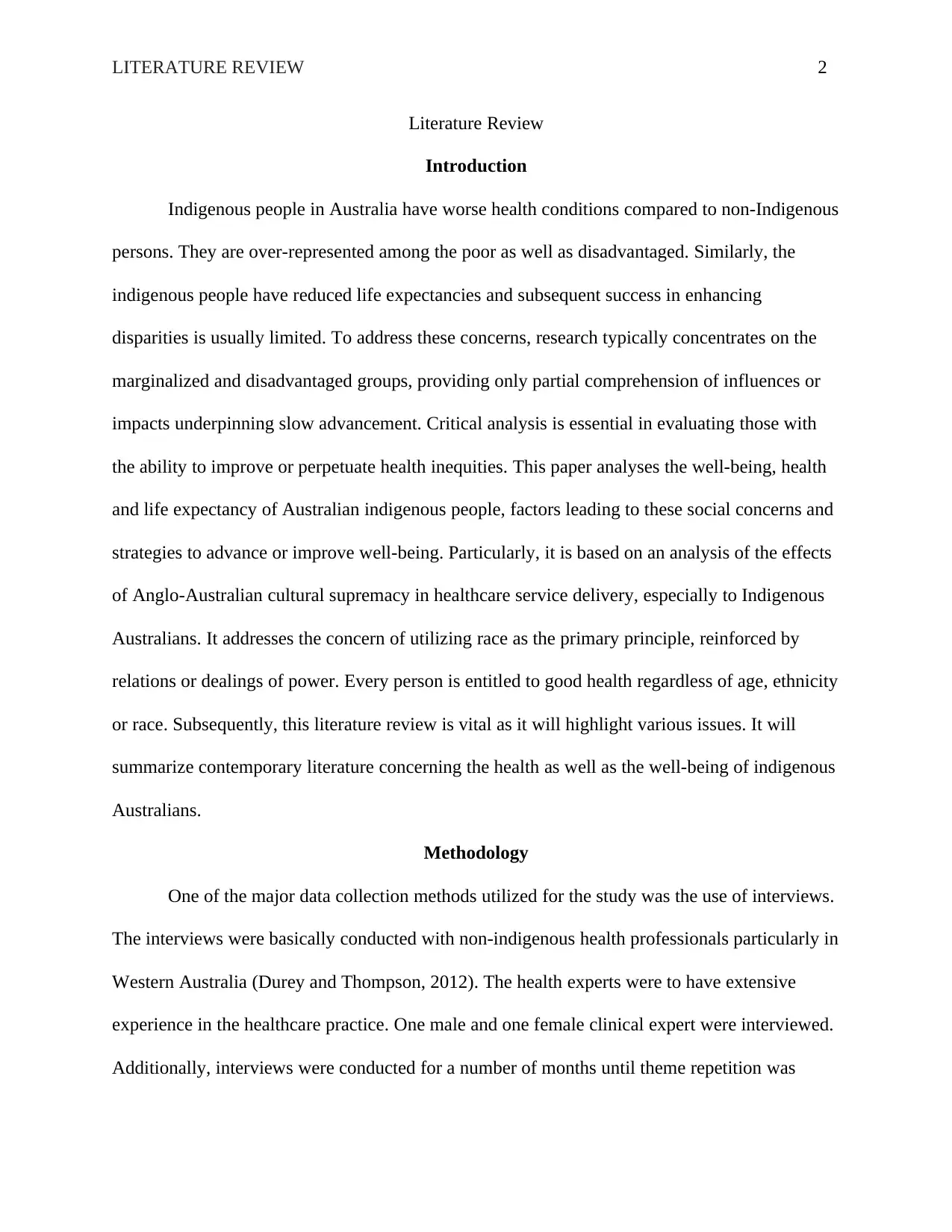
LITERATURE REVIEW 2
Literature Review
Introduction
Indigenous people in Australia have worse health conditions compared to non-Indigenous
persons. They are over-represented among the poor as well as disadvantaged. Similarly, the
indigenous people have reduced life expectancies and subsequent success in enhancing
disparities is usually limited. To address these concerns, research typically concentrates on the
marginalized and disadvantaged groups, providing only partial comprehension of influences or
impacts underpinning slow advancement. Critical analysis is essential in evaluating those with
the ability to improve or perpetuate health inequities. This paper analyses the well-being, health
and life expectancy of Australian indigenous people, factors leading to these social concerns and
strategies to advance or improve well-being. Particularly, it is based on an analysis of the effects
of Anglo-Australian cultural supremacy in healthcare service delivery, especially to Indigenous
Australians. It addresses the concern of utilizing race as the primary principle, reinforced by
relations or dealings of power. Every person is entitled to good health regardless of age, ethnicity
or race. Subsequently, this literature review is vital as it will highlight various issues. It will
summarize contemporary literature concerning the health as well as the well-being of indigenous
Australians.
Methodology
One of the major data collection methods utilized for the study was the use of interviews.
The interviews were basically conducted with non-indigenous health professionals particularly in
Western Australia (Durey and Thompson, 2012). The health experts were to have extensive
experience in the healthcare practice. One male and one female clinical expert were interviewed.
Additionally, interviews were conducted for a number of months until theme repetition was
Literature Review
Introduction
Indigenous people in Australia have worse health conditions compared to non-Indigenous
persons. They are over-represented among the poor as well as disadvantaged. Similarly, the
indigenous people have reduced life expectancies and subsequent success in enhancing
disparities is usually limited. To address these concerns, research typically concentrates on the
marginalized and disadvantaged groups, providing only partial comprehension of influences or
impacts underpinning slow advancement. Critical analysis is essential in evaluating those with
the ability to improve or perpetuate health inequities. This paper analyses the well-being, health
and life expectancy of Australian indigenous people, factors leading to these social concerns and
strategies to advance or improve well-being. Particularly, it is based on an analysis of the effects
of Anglo-Australian cultural supremacy in healthcare service delivery, especially to Indigenous
Australians. It addresses the concern of utilizing race as the primary principle, reinforced by
relations or dealings of power. Every person is entitled to good health regardless of age, ethnicity
or race. Subsequently, this literature review is vital as it will highlight various issues. It will
summarize contemporary literature concerning the health as well as the well-being of indigenous
Australians.
Methodology
One of the major data collection methods utilized for the study was the use of interviews.
The interviews were basically conducted with non-indigenous health professionals particularly in
Western Australia (Durey and Thompson, 2012). The health experts were to have extensive
experience in the healthcare practice. One male and one female clinical expert were interviewed.
Additionally, interviews were conducted for a number of months until theme repetition was
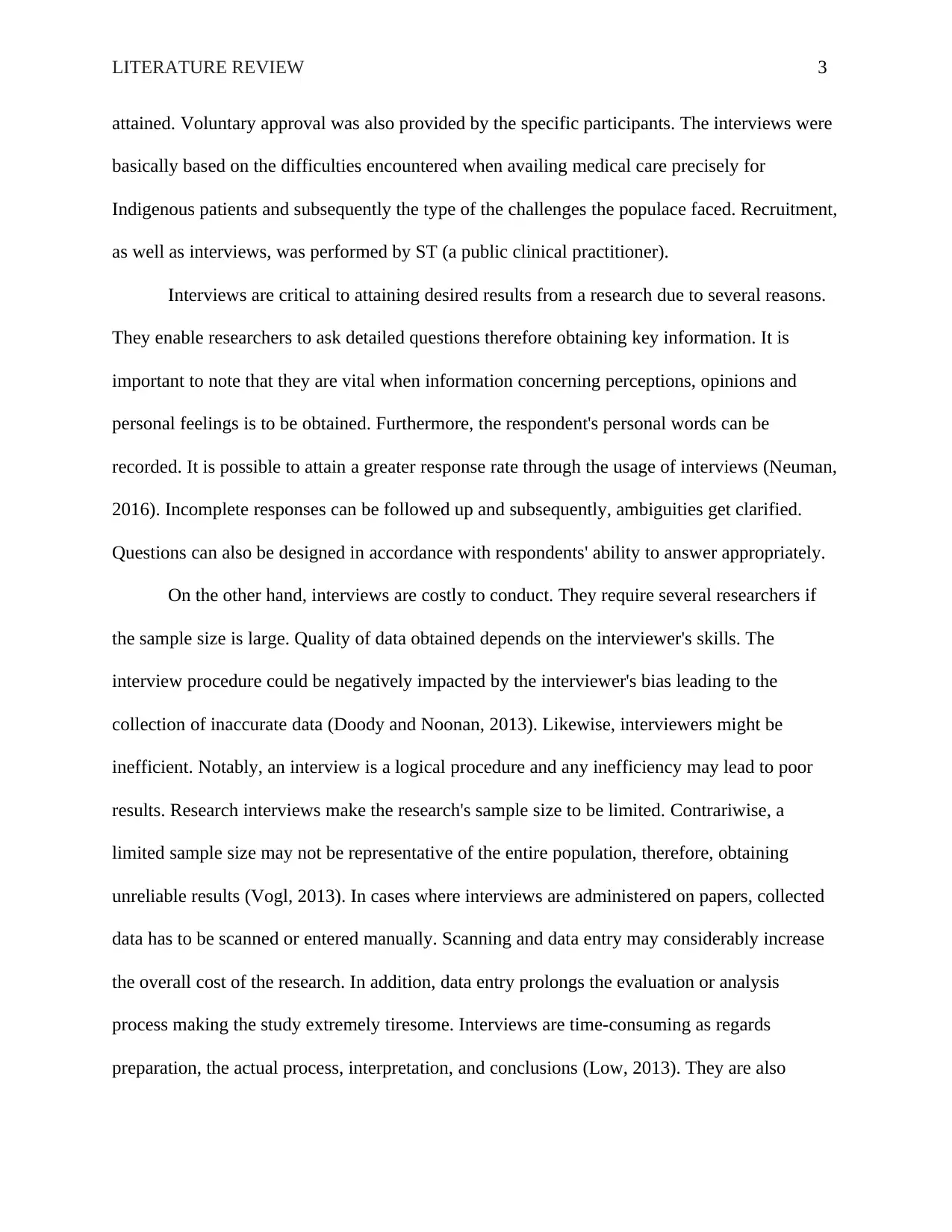
LITERATURE REVIEW 3
attained. Voluntary approval was also provided by the specific participants. The interviews were
basically based on the difficulties encountered when availing medical care precisely for
Indigenous patients and subsequently the type of the challenges the populace faced. Recruitment,
as well as interviews, was performed by ST (a public clinical practitioner).
Interviews are critical to attaining desired results from a research due to several reasons.
They enable researchers to ask detailed questions therefore obtaining key information. It is
important to note that they are vital when information concerning perceptions, opinions and
personal feelings is to be obtained. Furthermore, the respondent's personal words can be
recorded. It is possible to attain a greater response rate through the usage of interviews (Neuman,
2016). Incomplete responses can be followed up and subsequently, ambiguities get clarified.
Questions can also be designed in accordance with respondents' ability to answer appropriately.
On the other hand, interviews are costly to conduct. They require several researchers if
the sample size is large. Quality of data obtained depends on the interviewer's skills. The
interview procedure could be negatively impacted by the interviewer's bias leading to the
collection of inaccurate data (Doody and Noonan, 2013). Likewise, interviewers might be
inefficient. Notably, an interview is a logical procedure and any inefficiency may lead to poor
results. Research interviews make the research's sample size to be limited. Contrariwise, a
limited sample size may not be representative of the entire population, therefore, obtaining
unreliable results (Vogl, 2013). In cases where interviews are administered on papers, collected
data has to be scanned or entered manually. Scanning and data entry may considerably increase
the overall cost of the research. In addition, data entry prolongs the evaluation or analysis
process making the study extremely tiresome. Interviews are time-consuming as regards
preparation, the actual process, interpretation, and conclusions (Low, 2013). They are also
attained. Voluntary approval was also provided by the specific participants. The interviews were
basically based on the difficulties encountered when availing medical care precisely for
Indigenous patients and subsequently the type of the challenges the populace faced. Recruitment,
as well as interviews, was performed by ST (a public clinical practitioner).
Interviews are critical to attaining desired results from a research due to several reasons.
They enable researchers to ask detailed questions therefore obtaining key information. It is
important to note that they are vital when information concerning perceptions, opinions and
personal feelings is to be obtained. Furthermore, the respondent's personal words can be
recorded. It is possible to attain a greater response rate through the usage of interviews (Neuman,
2016). Incomplete responses can be followed up and subsequently, ambiguities get clarified.
Questions can also be designed in accordance with respondents' ability to answer appropriately.
On the other hand, interviews are costly to conduct. They require several researchers if
the sample size is large. Quality of data obtained depends on the interviewer's skills. The
interview procedure could be negatively impacted by the interviewer's bias leading to the
collection of inaccurate data (Doody and Noonan, 2013). Likewise, interviewers might be
inefficient. Notably, an interview is a logical procedure and any inefficiency may lead to poor
results. Research interviews make the research's sample size to be limited. Contrariwise, a
limited sample size may not be representative of the entire population, therefore, obtaining
unreliable results (Vogl, 2013). In cases where interviews are administered on papers, collected
data has to be scanned or entered manually. Scanning and data entry may considerably increase
the overall cost of the research. In addition, data entry prolongs the evaluation or analysis
process making the study extremely tiresome. Interviews are time-consuming as regards
preparation, the actual process, interpretation, and conclusions (Low, 2013). They are also
⊘ This is a preview!⊘
Do you want full access?
Subscribe today to unlock all pages.

Trusted by 1+ million students worldwide
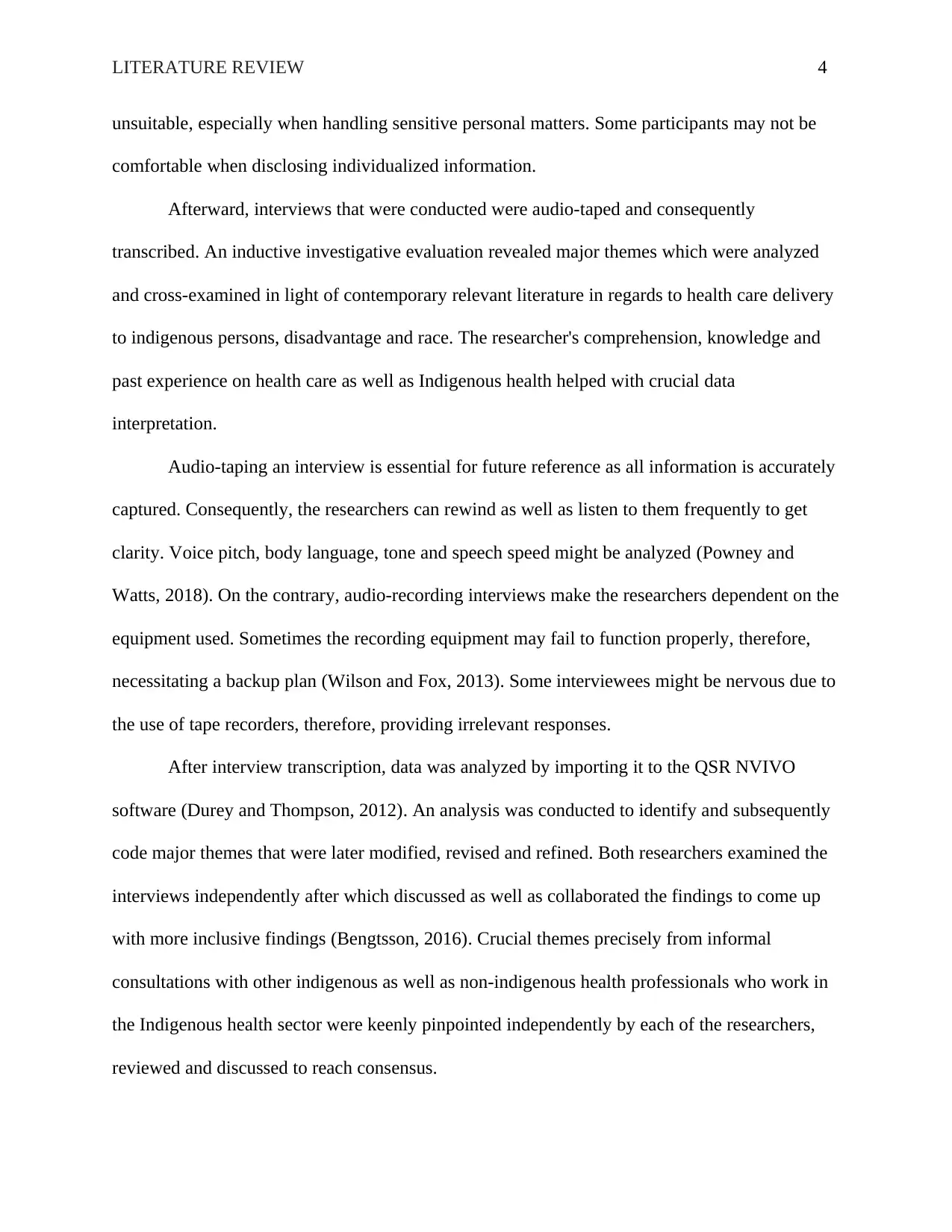
LITERATURE REVIEW 4
unsuitable, especially when handling sensitive personal matters. Some participants may not be
comfortable when disclosing individualized information.
Afterward, interviews that were conducted were audio-taped and consequently
transcribed. An inductive investigative evaluation revealed major themes which were analyzed
and cross-examined in light of contemporary relevant literature in regards to health care delivery
to indigenous persons, disadvantage and race. The researcher's comprehension, knowledge and
past experience on health care as well as Indigenous health helped with crucial data
interpretation.
Audio-taping an interview is essential for future reference as all information is accurately
captured. Consequently, the researchers can rewind as well as listen to them frequently to get
clarity. Voice pitch, body language, tone and speech speed might be analyzed (Powney and
Watts, 2018). On the contrary, audio-recording interviews make the researchers dependent on the
equipment used. Sometimes the recording equipment may fail to function properly, therefore,
necessitating a backup plan (Wilson and Fox, 2013). Some interviewees might be nervous due to
the use of tape recorders, therefore, providing irrelevant responses.
After interview transcription, data was analyzed by importing it to the QSR NVIVO
software (Durey and Thompson, 2012). An analysis was conducted to identify and subsequently
code major themes that were later modified, revised and refined. Both researchers examined the
interviews independently after which discussed as well as collaborated the findings to come up
with more inclusive findings (Bengtsson, 2016). Crucial themes precisely from informal
consultations with other indigenous as well as non-indigenous health professionals who work in
the Indigenous health sector were keenly pinpointed independently by each of the researchers,
reviewed and discussed to reach consensus.
unsuitable, especially when handling sensitive personal matters. Some participants may not be
comfortable when disclosing individualized information.
Afterward, interviews that were conducted were audio-taped and consequently
transcribed. An inductive investigative evaluation revealed major themes which were analyzed
and cross-examined in light of contemporary relevant literature in regards to health care delivery
to indigenous persons, disadvantage and race. The researcher's comprehension, knowledge and
past experience on health care as well as Indigenous health helped with crucial data
interpretation.
Audio-taping an interview is essential for future reference as all information is accurately
captured. Consequently, the researchers can rewind as well as listen to them frequently to get
clarity. Voice pitch, body language, tone and speech speed might be analyzed (Powney and
Watts, 2018). On the contrary, audio-recording interviews make the researchers dependent on the
equipment used. Sometimes the recording equipment may fail to function properly, therefore,
necessitating a backup plan (Wilson and Fox, 2013). Some interviewees might be nervous due to
the use of tape recorders, therefore, providing irrelevant responses.
After interview transcription, data was analyzed by importing it to the QSR NVIVO
software (Durey and Thompson, 2012). An analysis was conducted to identify and subsequently
code major themes that were later modified, revised and refined. Both researchers examined the
interviews independently after which discussed as well as collaborated the findings to come up
with more inclusive findings (Bengtsson, 2016). Crucial themes precisely from informal
consultations with other indigenous as well as non-indigenous health professionals who work in
the Indigenous health sector were keenly pinpointed independently by each of the researchers,
reviewed and discussed to reach consensus.
Paraphrase This Document
Need a fresh take? Get an instant paraphrase of this document with our AI Paraphraser
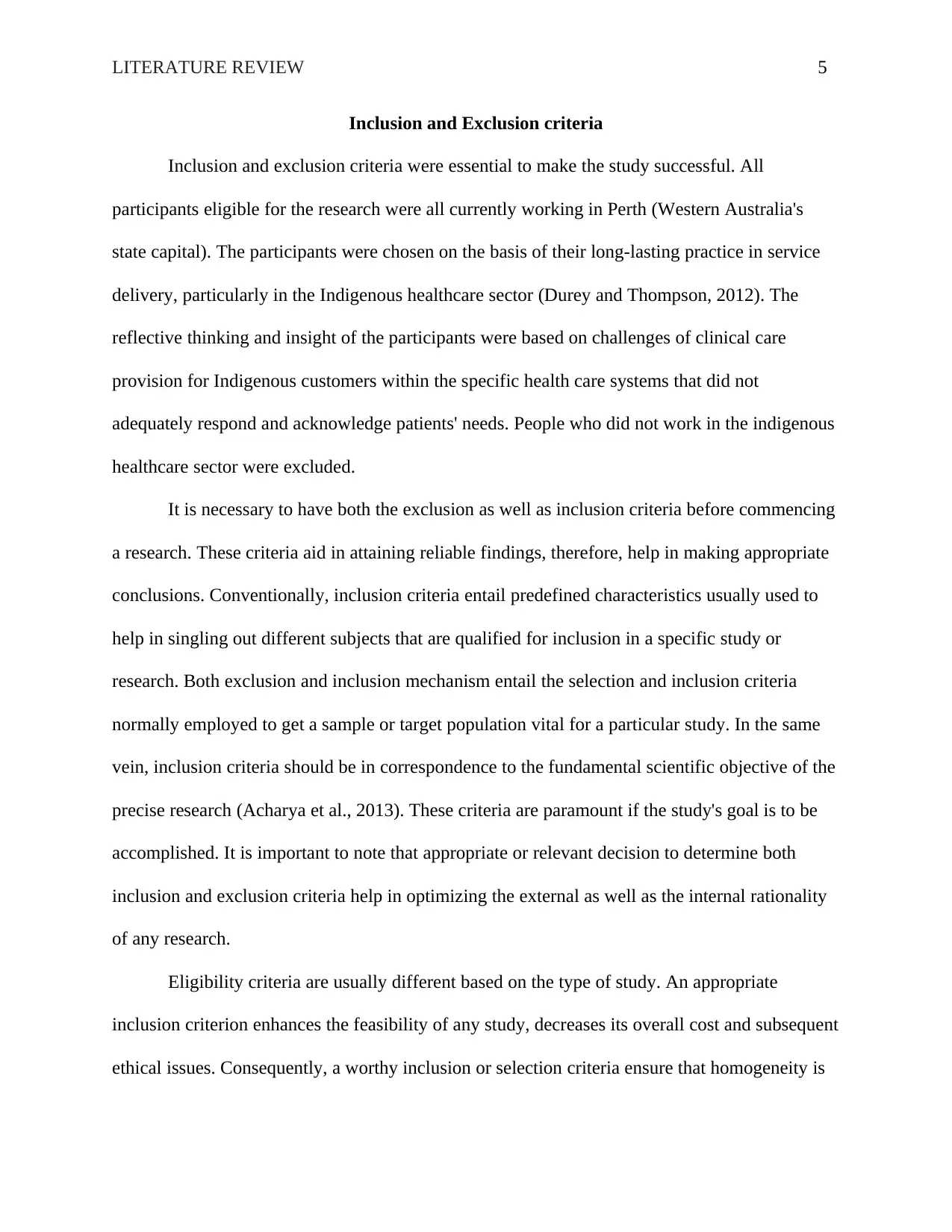
LITERATURE REVIEW 5
Inclusion and Exclusion criteria
Inclusion and exclusion criteria were essential to make the study successful. All
participants eligible for the research were all currently working in Perth (Western Australia's
state capital). The participants were chosen on the basis of their long-lasting practice in service
delivery, particularly in the Indigenous healthcare sector (Durey and Thompson, 2012). The
reflective thinking and insight of the participants were based on challenges of clinical care
provision for Indigenous customers within the specific health care systems that did not
adequately respond and acknowledge patients' needs. People who did not work in the indigenous
healthcare sector were excluded.
It is necessary to have both the exclusion as well as inclusion criteria before commencing
a research. These criteria aid in attaining reliable findings, therefore, help in making appropriate
conclusions. Conventionally, inclusion criteria entail predefined characteristics usually used to
help in singling out different subjects that are qualified for inclusion in a specific study or
research. Both exclusion and inclusion mechanism entail the selection and inclusion criteria
normally employed to get a sample or target population vital for a particular study. In the same
vein, inclusion criteria should be in correspondence to the fundamental scientific objective of the
precise research (Acharya et al., 2013). These criteria are paramount if the study's goal is to be
accomplished. It is important to note that appropriate or relevant decision to determine both
inclusion and exclusion criteria help in optimizing the external as well as the internal rationality
of any research.
Eligibility criteria are usually different based on the type of study. An appropriate
inclusion criterion enhances the feasibility of any study, decreases its overall cost and subsequent
ethical issues. Consequently, a worthy inclusion or selection criteria ensure that homogeneity is
Inclusion and Exclusion criteria
Inclusion and exclusion criteria were essential to make the study successful. All
participants eligible for the research were all currently working in Perth (Western Australia's
state capital). The participants were chosen on the basis of their long-lasting practice in service
delivery, particularly in the Indigenous healthcare sector (Durey and Thompson, 2012). The
reflective thinking and insight of the participants were based on challenges of clinical care
provision for Indigenous customers within the specific health care systems that did not
adequately respond and acknowledge patients' needs. People who did not work in the indigenous
healthcare sector were excluded.
It is necessary to have both the exclusion as well as inclusion criteria before commencing
a research. These criteria aid in attaining reliable findings, therefore, help in making appropriate
conclusions. Conventionally, inclusion criteria entail predefined characteristics usually used to
help in singling out different subjects that are qualified for inclusion in a specific study or
research. Both exclusion and inclusion mechanism entail the selection and inclusion criteria
normally employed to get a sample or target population vital for a particular study. In the same
vein, inclusion criteria should be in correspondence to the fundamental scientific objective of the
precise research (Acharya et al., 2013). These criteria are paramount if the study's goal is to be
accomplished. It is important to note that appropriate or relevant decision to determine both
inclusion and exclusion criteria help in optimizing the external as well as the internal rationality
of any research.
Eligibility criteria are usually different based on the type of study. An appropriate
inclusion criterion enhances the feasibility of any study, decreases its overall cost and subsequent
ethical issues. Consequently, a worthy inclusion or selection criteria ensure that homogeneity is
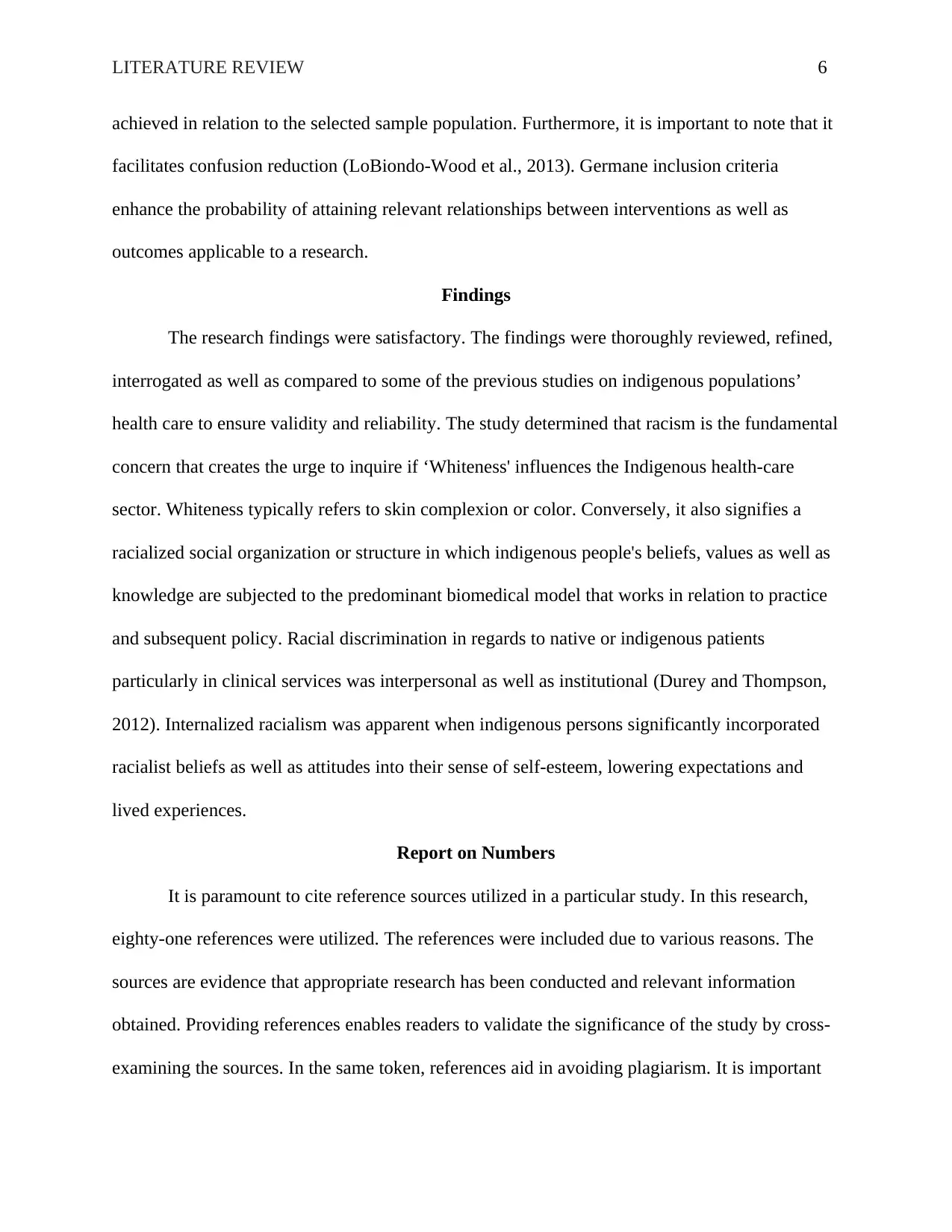
LITERATURE REVIEW 6
achieved in relation to the selected sample population. Furthermore, it is important to note that it
facilitates confusion reduction (LoBiondo-Wood et al., 2013). Germane inclusion criteria
enhance the probability of attaining relevant relationships between interventions as well as
outcomes applicable to a research.
Findings
The research findings were satisfactory. The findings were thoroughly reviewed, refined,
interrogated as well as compared to some of the previous studies on indigenous populations’
health care to ensure validity and reliability. The study determined that racism is the fundamental
concern that creates the urge to inquire if ‘Whiteness' influences the Indigenous health-care
sector. Whiteness typically refers to skin complexion or color. Conversely, it also signifies a
racialized social organization or structure in which indigenous people's beliefs, values as well as
knowledge are subjected to the predominant biomedical model that works in relation to practice
and subsequent policy. Racial discrimination in regards to native or indigenous patients
particularly in clinical services was interpersonal as well as institutional (Durey and Thompson,
2012). Internalized racialism was apparent when indigenous persons significantly incorporated
racialist beliefs as well as attitudes into their sense of self-esteem, lowering expectations and
lived experiences.
Report on Numbers
It is paramount to cite reference sources utilized in a particular study. In this research,
eighty-one references were utilized. The references were included due to various reasons. The
sources are evidence that appropriate research has been conducted and relevant information
obtained. Providing references enables readers to validate the significance of the study by cross-
examining the sources. In the same token, references aid in avoiding plagiarism. It is important
achieved in relation to the selected sample population. Furthermore, it is important to note that it
facilitates confusion reduction (LoBiondo-Wood et al., 2013). Germane inclusion criteria
enhance the probability of attaining relevant relationships between interventions as well as
outcomes applicable to a research.
Findings
The research findings were satisfactory. The findings were thoroughly reviewed, refined,
interrogated as well as compared to some of the previous studies on indigenous populations’
health care to ensure validity and reliability. The study determined that racism is the fundamental
concern that creates the urge to inquire if ‘Whiteness' influences the Indigenous health-care
sector. Whiteness typically refers to skin complexion or color. Conversely, it also signifies a
racialized social organization or structure in which indigenous people's beliefs, values as well as
knowledge are subjected to the predominant biomedical model that works in relation to practice
and subsequent policy. Racial discrimination in regards to native or indigenous patients
particularly in clinical services was interpersonal as well as institutional (Durey and Thompson,
2012). Internalized racialism was apparent when indigenous persons significantly incorporated
racialist beliefs as well as attitudes into their sense of self-esteem, lowering expectations and
lived experiences.
Report on Numbers
It is paramount to cite reference sources utilized in a particular study. In this research,
eighty-one references were utilized. The references were included due to various reasons. The
sources are evidence that appropriate research has been conducted and relevant information
obtained. Providing references enables readers to validate the significance of the study by cross-
examining the sources. In the same token, references aid in avoiding plagiarism. It is important
⊘ This is a preview!⊘
Do you want full access?
Subscribe today to unlock all pages.

Trusted by 1+ million students worldwide
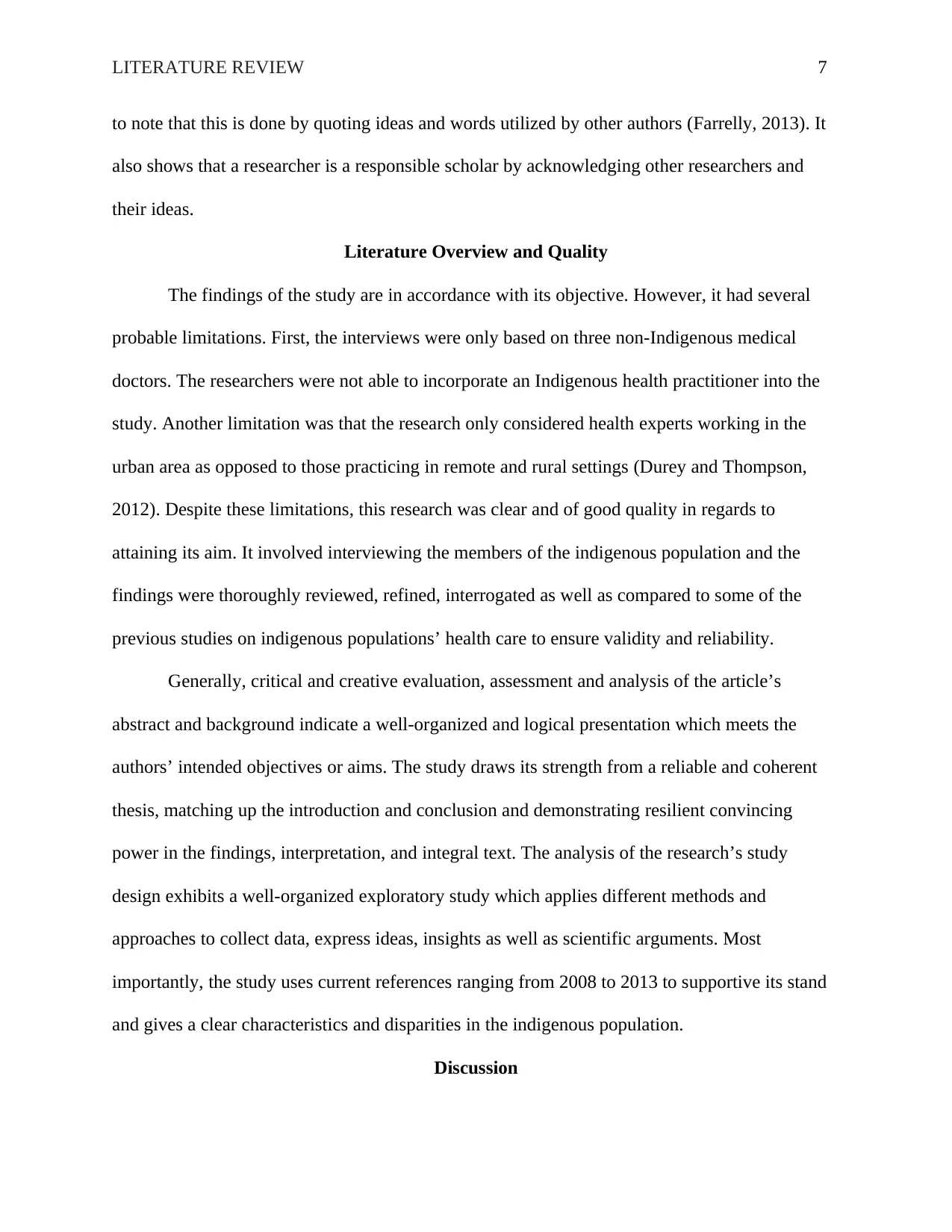
LITERATURE REVIEW 7
to note that this is done by quoting ideas and words utilized by other authors (Farrelly, 2013). It
also shows that a researcher is a responsible scholar by acknowledging other researchers and
their ideas.
Literature Overview and Quality
The findings of the study are in accordance with its objective. However, it had several
probable limitations. First, the interviews were only based on three non-Indigenous medical
doctors. The researchers were not able to incorporate an Indigenous health practitioner into the
study. Another limitation was that the research only considered health experts working in the
urban area as opposed to those practicing in remote and rural settings (Durey and Thompson,
2012). Despite these limitations, this research was clear and of good quality in regards to
attaining its aim. It involved interviewing the members of the indigenous population and the
findings were thoroughly reviewed, refined, interrogated as well as compared to some of the
previous studies on indigenous populations’ health care to ensure validity and reliability.
Generally, critical and creative evaluation, assessment and analysis of the article’s
abstract and background indicate a well-organized and logical presentation which meets the
authors’ intended objectives or aims. The study draws its strength from a reliable and coherent
thesis, matching up the introduction and conclusion and demonstrating resilient convincing
power in the findings, interpretation, and integral text. The analysis of the research’s study
design exhibits a well-organized exploratory study which applies different methods and
approaches to collect data, express ideas, insights as well as scientific arguments. Most
importantly, the study uses current references ranging from 2008 to 2013 to supportive its stand
and gives a clear characteristics and disparities in the indigenous population.
Discussion
to note that this is done by quoting ideas and words utilized by other authors (Farrelly, 2013). It
also shows that a researcher is a responsible scholar by acknowledging other researchers and
their ideas.
Literature Overview and Quality
The findings of the study are in accordance with its objective. However, it had several
probable limitations. First, the interviews were only based on three non-Indigenous medical
doctors. The researchers were not able to incorporate an Indigenous health practitioner into the
study. Another limitation was that the research only considered health experts working in the
urban area as opposed to those practicing in remote and rural settings (Durey and Thompson,
2012). Despite these limitations, this research was clear and of good quality in regards to
attaining its aim. It involved interviewing the members of the indigenous population and the
findings were thoroughly reviewed, refined, interrogated as well as compared to some of the
previous studies on indigenous populations’ health care to ensure validity and reliability.
Generally, critical and creative evaluation, assessment and analysis of the article’s
abstract and background indicate a well-organized and logical presentation which meets the
authors’ intended objectives or aims. The study draws its strength from a reliable and coherent
thesis, matching up the introduction and conclusion and demonstrating resilient convincing
power in the findings, interpretation, and integral text. The analysis of the research’s study
design exhibits a well-organized exploratory study which applies different methods and
approaches to collect data, express ideas, insights as well as scientific arguments. Most
importantly, the study uses current references ranging from 2008 to 2013 to supportive its stand
and gives a clear characteristics and disparities in the indigenous population.
Discussion
Paraphrase This Document
Need a fresh take? Get an instant paraphrase of this document with our AI Paraphraser
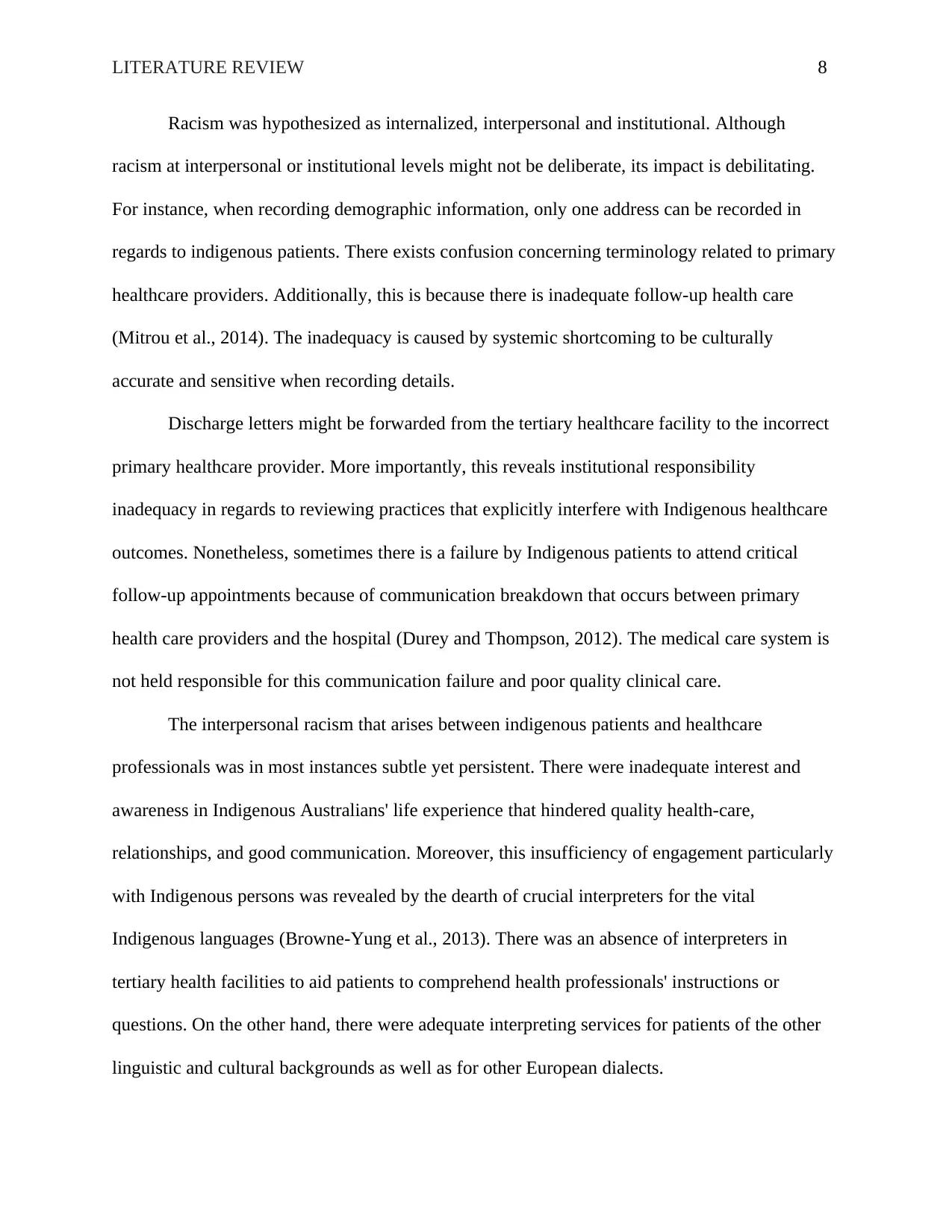
LITERATURE REVIEW 8
Racism was hypothesized as internalized, interpersonal and institutional. Although
racism at interpersonal or institutional levels might not be deliberate, its impact is debilitating.
For instance, when recording demographic information, only one address can be recorded in
regards to indigenous patients. There exists confusion concerning terminology related to primary
healthcare providers. Additionally, this is because there is inadequate follow-up health care
(Mitrou et al., 2014). The inadequacy is caused by systemic shortcoming to be culturally
accurate and sensitive when recording details.
Discharge letters might be forwarded from the tertiary healthcare facility to the incorrect
primary healthcare provider. More importantly, this reveals institutional responsibility
inadequacy in regards to reviewing practices that explicitly interfere with Indigenous healthcare
outcomes. Nonetheless, sometimes there is a failure by Indigenous patients to attend critical
follow-up appointments because of communication breakdown that occurs between primary
health care providers and the hospital (Durey and Thompson, 2012). The medical care system is
not held responsible for this communication failure and poor quality clinical care.
The interpersonal racism that arises between indigenous patients and healthcare
professionals was in most instances subtle yet persistent. There were inadequate interest and
awareness in Indigenous Australians' life experience that hindered quality health-care,
relationships, and good communication. Moreover, this insufficiency of engagement particularly
with Indigenous persons was revealed by the dearth of crucial interpreters for the vital
Indigenous languages (Browne-Yung et al., 2013). There was an absence of interpreters in
tertiary health facilities to aid patients to comprehend health professionals' instructions or
questions. On the other hand, there were adequate interpreting services for patients of the other
linguistic and cultural backgrounds as well as for other European dialects.
Racism was hypothesized as internalized, interpersonal and institutional. Although
racism at interpersonal or institutional levels might not be deliberate, its impact is debilitating.
For instance, when recording demographic information, only one address can be recorded in
regards to indigenous patients. There exists confusion concerning terminology related to primary
healthcare providers. Additionally, this is because there is inadequate follow-up health care
(Mitrou et al., 2014). The inadequacy is caused by systemic shortcoming to be culturally
accurate and sensitive when recording details.
Discharge letters might be forwarded from the tertiary healthcare facility to the incorrect
primary healthcare provider. More importantly, this reveals institutional responsibility
inadequacy in regards to reviewing practices that explicitly interfere with Indigenous healthcare
outcomes. Nonetheless, sometimes there is a failure by Indigenous patients to attend critical
follow-up appointments because of communication breakdown that occurs between primary
health care providers and the hospital (Durey and Thompson, 2012). The medical care system is
not held responsible for this communication failure and poor quality clinical care.
The interpersonal racism that arises between indigenous patients and healthcare
professionals was in most instances subtle yet persistent. There were inadequate interest and
awareness in Indigenous Australians' life experience that hindered quality health-care,
relationships, and good communication. Moreover, this insufficiency of engagement particularly
with Indigenous persons was revealed by the dearth of crucial interpreters for the vital
Indigenous languages (Browne-Yung et al., 2013). There was an absence of interpreters in
tertiary health facilities to aid patients to comprehend health professionals' instructions or
questions. On the other hand, there were adequate interpreting services for patients of the other
linguistic and cultural backgrounds as well as for other European dialects.
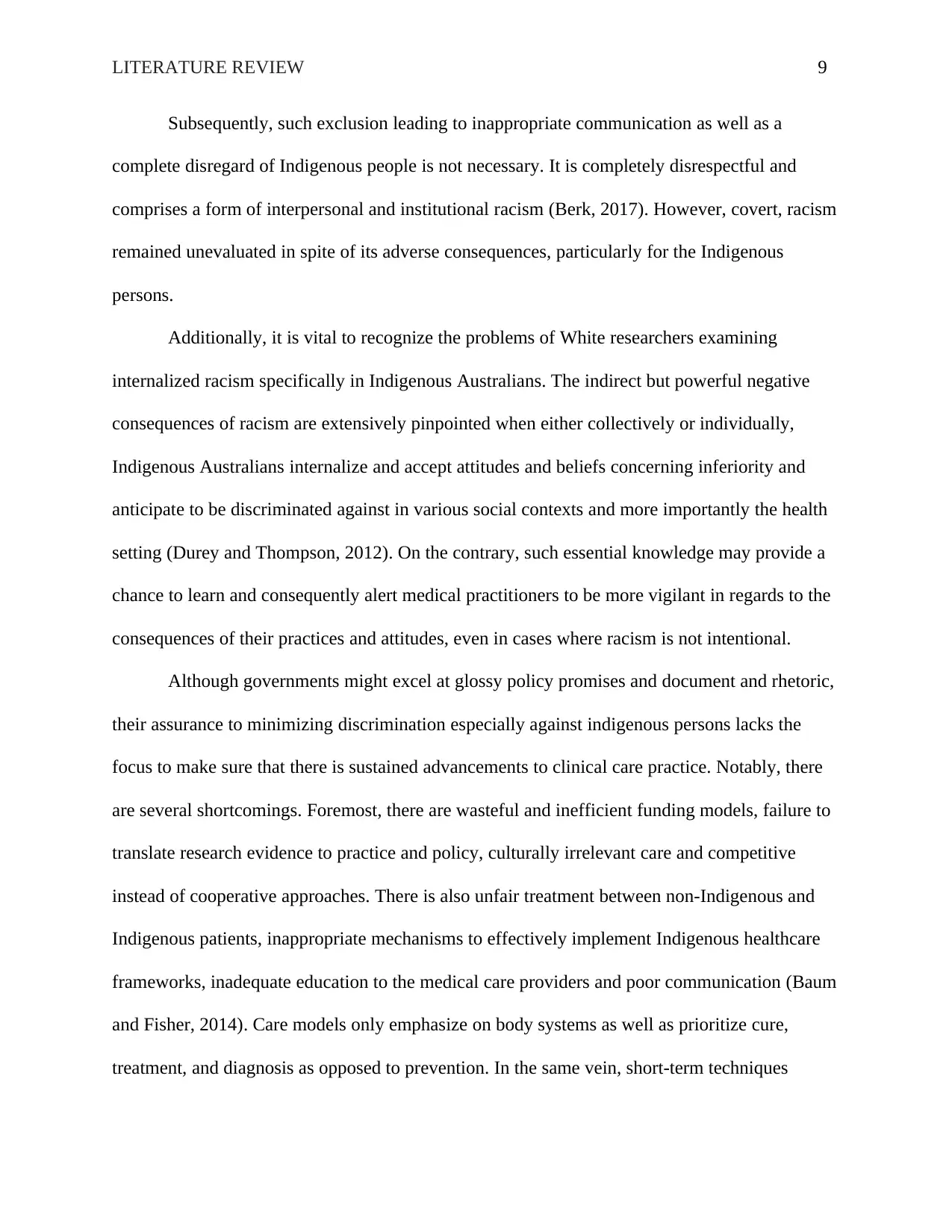
LITERATURE REVIEW 9
Subsequently, such exclusion leading to inappropriate communication as well as a
complete disregard of Indigenous people is not necessary. It is completely disrespectful and
comprises a form of interpersonal and institutional racism (Berk, 2017). However, covert, racism
remained unevaluated in spite of its adverse consequences, particularly for the Indigenous
persons.
Additionally, it is vital to recognize the problems of White researchers examining
internalized racism specifically in Indigenous Australians. The indirect but powerful negative
consequences of racism are extensively pinpointed when either collectively or individually,
Indigenous Australians internalize and accept attitudes and beliefs concerning inferiority and
anticipate to be discriminated against in various social contexts and more importantly the health
setting (Durey and Thompson, 2012). On the contrary, such essential knowledge may provide a
chance to learn and consequently alert medical practitioners to be more vigilant in regards to the
consequences of their practices and attitudes, even in cases where racism is not intentional.
Although governments might excel at glossy policy promises and document and rhetoric,
their assurance to minimizing discrimination especially against indigenous persons lacks the
focus to make sure that there is sustained advancements to clinical care practice. Notably, there
are several shortcomings. Foremost, there are wasteful and inefficient funding models, failure to
translate research evidence to practice and policy, culturally irrelevant care and competitive
instead of cooperative approaches. There is also unfair treatment between non-Indigenous and
Indigenous patients, inappropriate mechanisms to effectively implement Indigenous healthcare
frameworks, inadequate education to the medical care providers and poor communication (Baum
and Fisher, 2014). Care models only emphasize on body systems as well as prioritize cure,
treatment, and diagnosis as opposed to prevention. In the same vein, short-term techniques
Subsequently, such exclusion leading to inappropriate communication as well as a
complete disregard of Indigenous people is not necessary. It is completely disrespectful and
comprises a form of interpersonal and institutional racism (Berk, 2017). However, covert, racism
remained unevaluated in spite of its adverse consequences, particularly for the Indigenous
persons.
Additionally, it is vital to recognize the problems of White researchers examining
internalized racism specifically in Indigenous Australians. The indirect but powerful negative
consequences of racism are extensively pinpointed when either collectively or individually,
Indigenous Australians internalize and accept attitudes and beliefs concerning inferiority and
anticipate to be discriminated against in various social contexts and more importantly the health
setting (Durey and Thompson, 2012). On the contrary, such essential knowledge may provide a
chance to learn and consequently alert medical practitioners to be more vigilant in regards to the
consequences of their practices and attitudes, even in cases where racism is not intentional.
Although governments might excel at glossy policy promises and document and rhetoric,
their assurance to minimizing discrimination especially against indigenous persons lacks the
focus to make sure that there is sustained advancements to clinical care practice. Notably, there
are several shortcomings. Foremost, there are wasteful and inefficient funding models, failure to
translate research evidence to practice and policy, culturally irrelevant care and competitive
instead of cooperative approaches. There is also unfair treatment between non-Indigenous and
Indigenous patients, inappropriate mechanisms to effectively implement Indigenous healthcare
frameworks, inadequate education to the medical care providers and poor communication (Baum
and Fisher, 2014). Care models only emphasize on body systems as well as prioritize cure,
treatment, and diagnosis as opposed to prevention. In the same vein, short-term techniques
⊘ This is a preview!⊘
Do you want full access?
Subscribe today to unlock all pages.

Trusted by 1+ million students worldwide
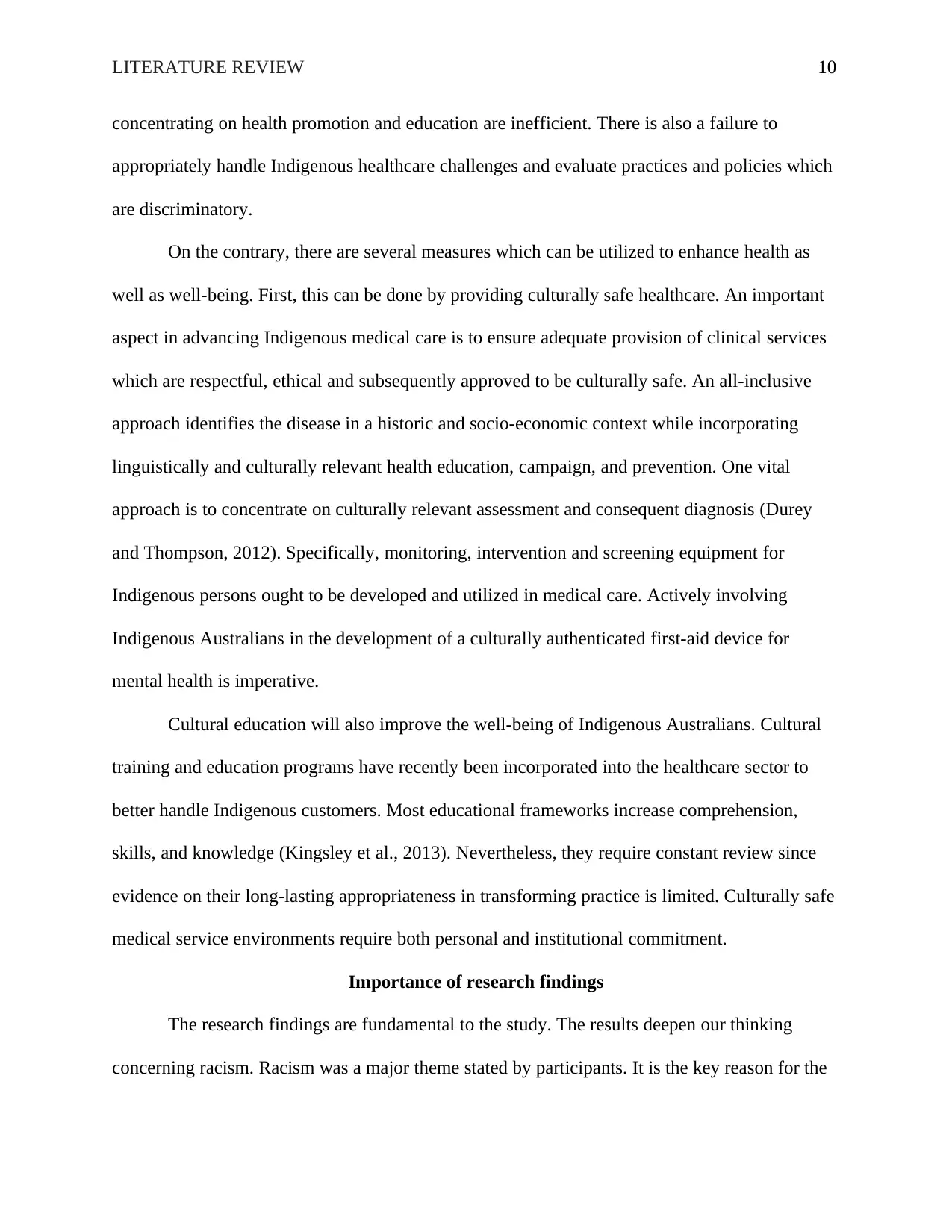
LITERATURE REVIEW 10
concentrating on health promotion and education are inefficient. There is also a failure to
appropriately handle Indigenous healthcare challenges and evaluate practices and policies which
are discriminatory.
On the contrary, there are several measures which can be utilized to enhance health as
well as well-being. First, this can be done by providing culturally safe healthcare. An important
aspect in advancing Indigenous medical care is to ensure adequate provision of clinical services
which are respectful, ethical and subsequently approved to be culturally safe. An all-inclusive
approach identifies the disease in a historic and socio-economic context while incorporating
linguistically and culturally relevant health education, campaign, and prevention. One vital
approach is to concentrate on culturally relevant assessment and consequent diagnosis (Durey
and Thompson, 2012). Specifically, monitoring, intervention and screening equipment for
Indigenous persons ought to be developed and utilized in medical care. Actively involving
Indigenous Australians in the development of a culturally authenticated first-aid device for
mental health is imperative.
Cultural education will also improve the well-being of Indigenous Australians. Cultural
training and education programs have recently been incorporated into the healthcare sector to
better handle Indigenous customers. Most educational frameworks increase comprehension,
skills, and knowledge (Kingsley et al., 2013). Nevertheless, they require constant review since
evidence on their long-lasting appropriateness in transforming practice is limited. Culturally safe
medical service environments require both personal and institutional commitment.
Importance of research findings
The research findings are fundamental to the study. The results deepen our thinking
concerning racism. Racism was a major theme stated by participants. It is the key reason for the
concentrating on health promotion and education are inefficient. There is also a failure to
appropriately handle Indigenous healthcare challenges and evaluate practices and policies which
are discriminatory.
On the contrary, there are several measures which can be utilized to enhance health as
well as well-being. First, this can be done by providing culturally safe healthcare. An important
aspect in advancing Indigenous medical care is to ensure adequate provision of clinical services
which are respectful, ethical and subsequently approved to be culturally safe. An all-inclusive
approach identifies the disease in a historic and socio-economic context while incorporating
linguistically and culturally relevant health education, campaign, and prevention. One vital
approach is to concentrate on culturally relevant assessment and consequent diagnosis (Durey
and Thompson, 2012). Specifically, monitoring, intervention and screening equipment for
Indigenous persons ought to be developed and utilized in medical care. Actively involving
Indigenous Australians in the development of a culturally authenticated first-aid device for
mental health is imperative.
Cultural education will also improve the well-being of Indigenous Australians. Cultural
training and education programs have recently been incorporated into the healthcare sector to
better handle Indigenous customers. Most educational frameworks increase comprehension,
skills, and knowledge (Kingsley et al., 2013). Nevertheless, they require constant review since
evidence on their long-lasting appropriateness in transforming practice is limited. Culturally safe
medical service environments require both personal and institutional commitment.
Importance of research findings
The research findings are fundamental to the study. The results deepen our thinking
concerning racism. Racism was a major theme stated by participants. It is the key reason for the
Paraphrase This Document
Need a fresh take? Get an instant paraphrase of this document with our AI Paraphraser
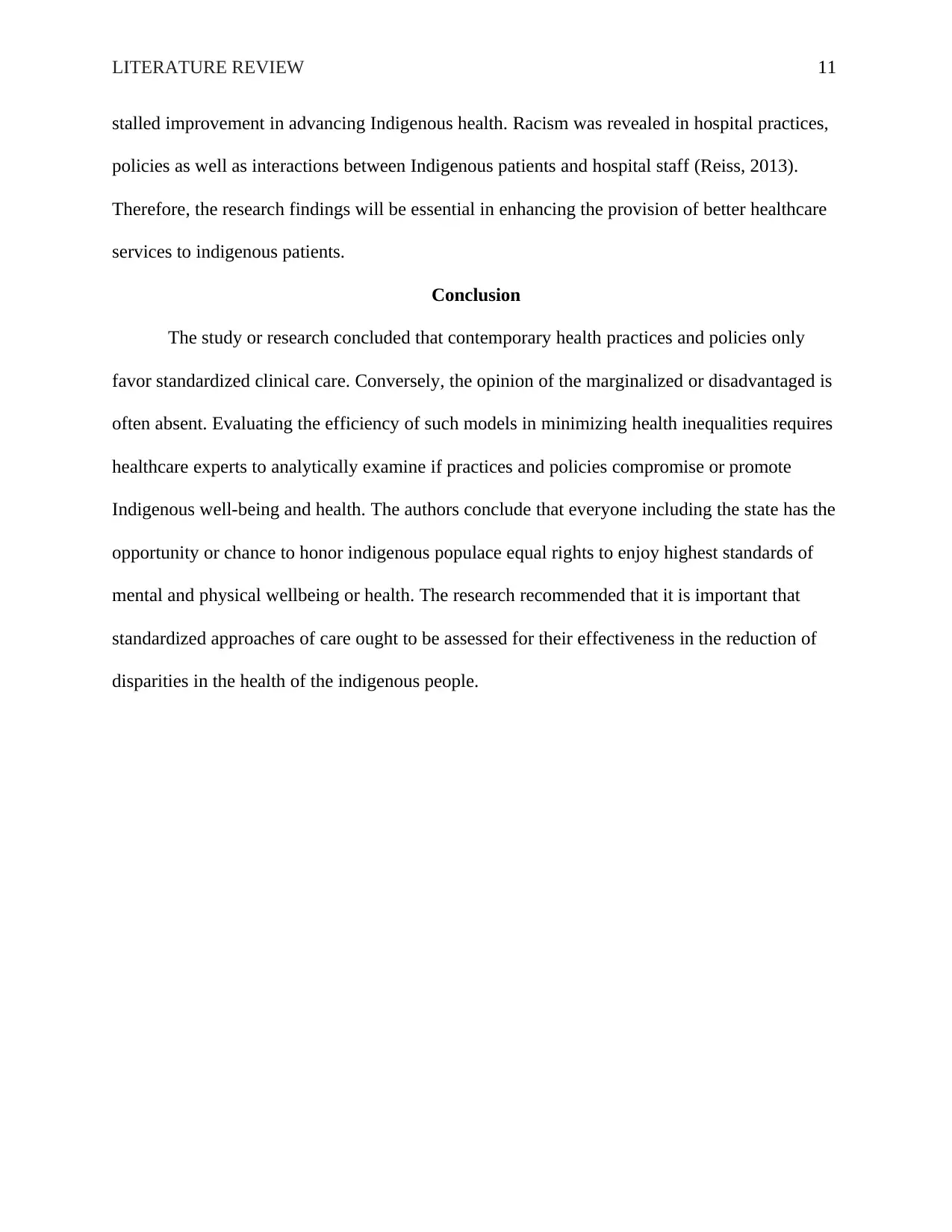
LITERATURE REVIEW 11
stalled improvement in advancing Indigenous health. Racism was revealed in hospital practices,
policies as well as interactions between Indigenous patients and hospital staff (Reiss, 2013).
Therefore, the research findings will be essential in enhancing the provision of better healthcare
services to indigenous patients.
Conclusion
The study or research concluded that contemporary health practices and policies only
favor standardized clinical care. Conversely, the opinion of the marginalized or disadvantaged is
often absent. Evaluating the efficiency of such models in minimizing health inequalities requires
healthcare experts to analytically examine if practices and policies compromise or promote
Indigenous well-being and health. The authors conclude that everyone including the state has the
opportunity or chance to honor indigenous populace equal rights to enjoy highest standards of
mental and physical wellbeing or health. The research recommended that it is important that
standardized approaches of care ought to be assessed for their effectiveness in the reduction of
disparities in the health of the indigenous people.
stalled improvement in advancing Indigenous health. Racism was revealed in hospital practices,
policies as well as interactions between Indigenous patients and hospital staff (Reiss, 2013).
Therefore, the research findings will be essential in enhancing the provision of better healthcare
services to indigenous patients.
Conclusion
The study or research concluded that contemporary health practices and policies only
favor standardized clinical care. Conversely, the opinion of the marginalized or disadvantaged is
often absent. Evaluating the efficiency of such models in minimizing health inequalities requires
healthcare experts to analytically examine if practices and policies compromise or promote
Indigenous well-being and health. The authors conclude that everyone including the state has the
opportunity or chance to honor indigenous populace equal rights to enjoy highest standards of
mental and physical wellbeing or health. The research recommended that it is important that
standardized approaches of care ought to be assessed for their effectiveness in the reduction of
disparities in the health of the indigenous people.
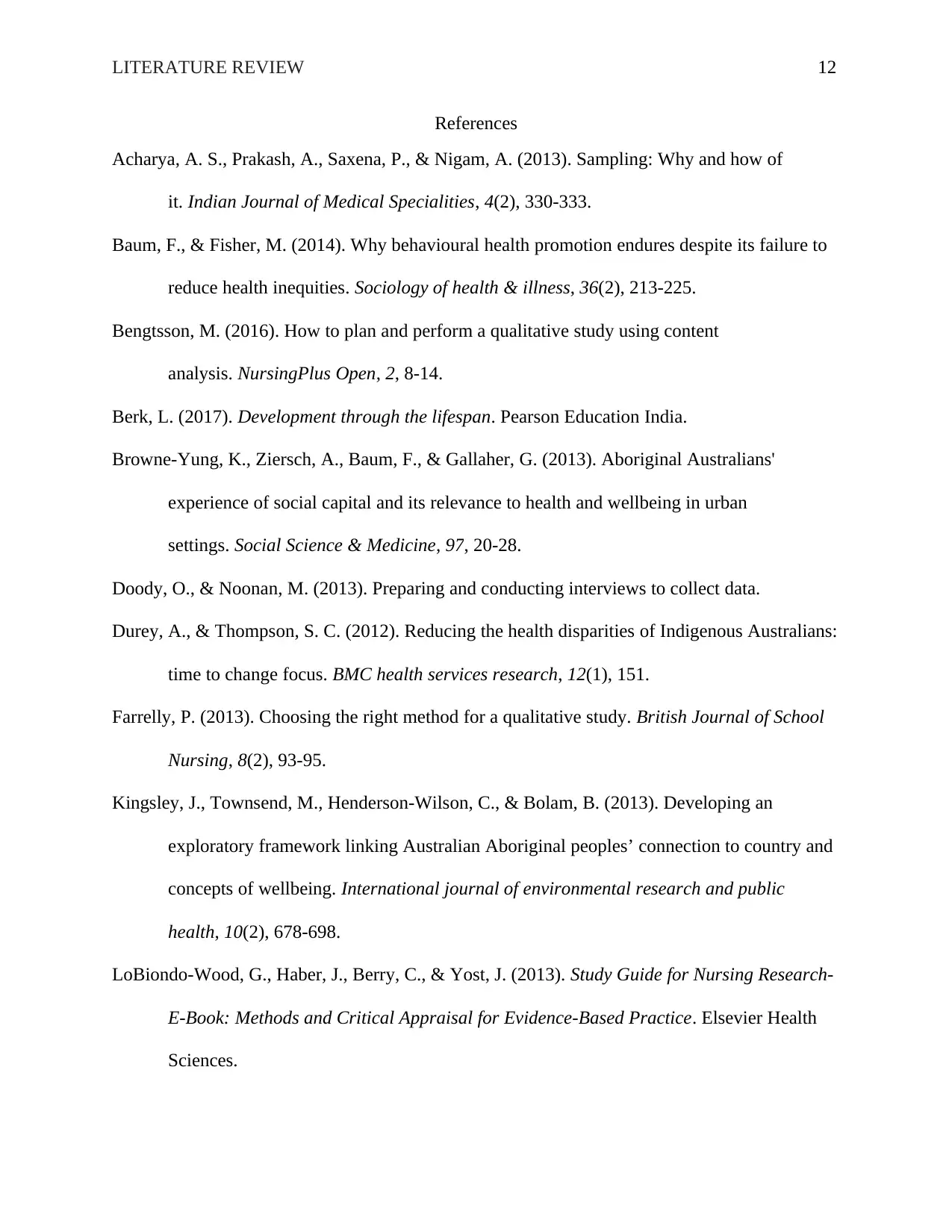
LITERATURE REVIEW 12
References
Acharya, A. S., Prakash, A., Saxena, P., & Nigam, A. (2013). Sampling: Why and how of
it. Indian Journal of Medical Specialities, 4(2), 330-333.
Baum, F., & Fisher, M. (2014). Why behavioural health promotion endures despite its failure to
reduce health inequities. Sociology of health & illness, 36(2), 213-225.
Bengtsson, M. (2016). How to plan and perform a qualitative study using content
analysis. NursingPlus Open, 2, 8-14.
Berk, L. (2017). Development through the lifespan. Pearson Education India.
Browne-Yung, K., Ziersch, A., Baum, F., & Gallaher, G. (2013). Aboriginal Australians'
experience of social capital and its relevance to health and wellbeing in urban
settings. Social Science & Medicine, 97, 20-28.
Doody, O., & Noonan, M. (2013). Preparing and conducting interviews to collect data.
Durey, A., & Thompson, S. C. (2012). Reducing the health disparities of Indigenous Australians:
time to change focus. BMC health services research, 12(1), 151.
Farrelly, P. (2013). Choosing the right method for a qualitative study. British Journal of School
Nursing, 8(2), 93-95.
Kingsley, J., Townsend, M., Henderson-Wilson, C., & Bolam, B. (2013). Developing an
exploratory framework linking Australian Aboriginal peoples’ connection to country and
concepts of wellbeing. International journal of environmental research and public
health, 10(2), 678-698.
LoBiondo-Wood, G., Haber, J., Berry, C., & Yost, J. (2013). Study Guide for Nursing Research-
E-Book: Methods and Critical Appraisal for Evidence-Based Practice. Elsevier Health
Sciences.
References
Acharya, A. S., Prakash, A., Saxena, P., & Nigam, A. (2013). Sampling: Why and how of
it. Indian Journal of Medical Specialities, 4(2), 330-333.
Baum, F., & Fisher, M. (2014). Why behavioural health promotion endures despite its failure to
reduce health inequities. Sociology of health & illness, 36(2), 213-225.
Bengtsson, M. (2016). How to plan and perform a qualitative study using content
analysis. NursingPlus Open, 2, 8-14.
Berk, L. (2017). Development through the lifespan. Pearson Education India.
Browne-Yung, K., Ziersch, A., Baum, F., & Gallaher, G. (2013). Aboriginal Australians'
experience of social capital and its relevance to health and wellbeing in urban
settings. Social Science & Medicine, 97, 20-28.
Doody, O., & Noonan, M. (2013). Preparing and conducting interviews to collect data.
Durey, A., & Thompson, S. C. (2012). Reducing the health disparities of Indigenous Australians:
time to change focus. BMC health services research, 12(1), 151.
Farrelly, P. (2013). Choosing the right method for a qualitative study. British Journal of School
Nursing, 8(2), 93-95.
Kingsley, J., Townsend, M., Henderson-Wilson, C., & Bolam, B. (2013). Developing an
exploratory framework linking Australian Aboriginal peoples’ connection to country and
concepts of wellbeing. International journal of environmental research and public
health, 10(2), 678-698.
LoBiondo-Wood, G., Haber, J., Berry, C., & Yost, J. (2013). Study Guide for Nursing Research-
E-Book: Methods and Critical Appraisal for Evidence-Based Practice. Elsevier Health
Sciences.
⊘ This is a preview!⊘
Do you want full access?
Subscribe today to unlock all pages.

Trusted by 1+ million students worldwide
1 out of 13
Related Documents
Your All-in-One AI-Powered Toolkit for Academic Success.
+13062052269
info@desklib.com
Available 24*7 on WhatsApp / Email
![[object Object]](/_next/static/media/star-bottom.7253800d.svg)
Unlock your academic potential
Copyright © 2020–2025 A2Z Services. All Rights Reserved. Developed and managed by ZUCOL.





